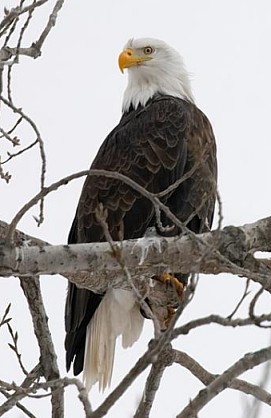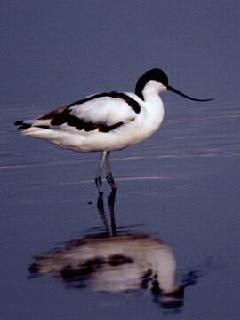Birds in the News #20

Photographer: Gene Oleynik, FermiLab
Birds in Science:
It was widely reported in the news that the space shuttle collided with a bird during its recent launch. These stories discuss how the astronauts are scanning the shuttle’s heat shield for potential damage using a new extension of the craft's robot arm.
Researchers report that club-winged manakins, Machaeropterus deliciosus, rub specialized feathers behind their backs to impress mates with a violin-like sound, researchers report. The manakins vibrate their wings at more than 100 cycles per second, twice the speed of hummingbirds. “Essentially an instrument has evolved in this species, in this case a refined instrument,” said Cornell University’s Kimberly Bostwick, the lead author. The findings are published in today's issue of the top-tier research journal Science.
These days, it seems, even the moral values of birds are subject to scrutiny. To investigate the spousal fidelity of eastern imperial eagles, Aquila heliaca heliaca, large raptors that are native to central Asia, a team of surreptitious scientists collected feathers the birds had shed near their nests in northern Kazakhstan. Extracting and analyzing DNA from the feathers confirmed that not a single eagle had strayed from its mate during the course of the six-year study - a degree of monogamy unusual among birds. In more than 75 percent of avian species looked at so far, researchers have discovered broods that have two or more fathers.
A rare bird-of-prey species, on the verge of becoming the focus of a last-ditch captive breeding program, doesn't exist, say researchers who studying the genes of the Cape Verde kite, Milvus fasciicauda. By comparing the mitochondrial DNA of five living Cape Verde kites with those of century-old museum specimens and related kites in Africa, Eurasia and Australia, researchers at the University of Michigan and the Peregrine Fund have discovered that the nearly extinct Cape Verde kite is really a couple of other common kites, depending on when you look. The results of the study by Mindell, and the Peregrine Fund's Jeff Johnson and Richard Watson, appear in the peer-reviewed scientific journal Proceedings of the Royal Society B.
Last week, nearly 2,000 of the world's leading environmental scientists of various disciplines met in Brasilia to present papers at the 19th Annual Meeting of the Society for Conservation Biology. The conference featured more than 750 oral presentations and 965 scientific abstracts. Listed on this link are a sampling of some of the bird conservation-related papers submitted for the conference. All descriptions are excepts from the official "Book of Abstracts" from the meeting.
People Hurting Birds:
Authorities are trying to figure out who took four endangered piping plovers, Charadrius melodus, from the sands of Duxbury Beach earlier this month. The alleged theft occurred on July 10 in this town 33 miles south of Boston. On that Sunday afternoon, shocked beachgoers reported seeing a woman and a teenager picking up piping plovers from a fenced-off area of the beach. Throughout the 19th century, piping plovers were hunted for their feathers, which were used to decorate hats. The species was nearly wiped out until federal protection laws were passed in 1918. Since then, piping plovers have slowly recovered. More recent news about piping plovers.
People Helping Birds:
 The Humber Estuary has become one of the most successful breeding grounds for a rare British bird. More than 100 pairs of pied avocets, Recurvirostra avosetta (pictured), have nested on Reads Island this year, raising at least 120 chicks.
The Humber Estuary has become one of the most successful breeding grounds for a rare British bird. More than 100 pairs of pied avocets, Recurvirostra avosetta (pictured), have nested on Reads Island this year, raising at least 120 chicks.Well, who would have thought it, but there are bald eagles, Haliaeetus leucocephalus, nesting within a couple blocks of where I myself nest in Manhattan! Apparently, four fledgling raptors are calling a platform above the Inwood Hill Park their home, as part of a city Parks Department project to reintroduce this iconic bird to New York. The article has a link to a live feed of the birds.
Following a 98% crash in numbers due to predation by feral housecats, the seabird population on Ascension Island is beginning to recover its numbers, mostly confined to those birds nesting on offshore stacks and inaccessible cliffs. After finally removing the last of the feral housecats from the islands in early 2004, the Ascension Seabird Restoration Project has released a special stamp commemorating the return of some of the endemic seabird species.
Two osprey chicks, Pandion haliaetus, were getting ready to fly for the first time at Glaslyn, in Northern Wales, UK. Experts ringed the fledglings at the same time when they weighed and measured them, determined to keep track of them.
Ivory-billed Woodpecker News:
This is an interesting story about a woman who saw the ivory-billed woodpecker, Campephilus principalis, in the Cache NWR in Arkansas in April 2005 (just before the public announcement). Incidentally, she was not part of the Cornell Team nor was her sighting mentioned in either the Science article or Gallagher's book.
Southeastern wildlife officials plan to gather next month to decide how far to expand their search for the recently rediscovered ivory-billed woodpecker - and the path could lead to Georgia. The bird once lived across the Southeast, including the Altamaha and Savannah rivers and the Okefenokee Swamp. "It would be a long shot, but if we were going to find it, it would be in places like that," said Terry Johnson, manager of the nongame endangered wildlife program for the state Department of Natural Resources.
Birds in the Media:
The loquacious chat starts this week out on BirdNote, followed by peregrines, Falco peregrinus and shorebirds; the red crossbill, Loxia curvirostra; birds that are named for their call or song; and the gray jay, Perisoreus canadensis. Check out the schedule and see photographs of the birds here. Also available as an RSS/PodCast Feed.
I have linked to this website before, but I am doing it again in case you missed it the first time. This website has collected a gazillion nesting bird cam links from around the planet for your viewing pleasure. They are categorized by species.
Bird Mysteries:
The mysterious deaths of at least 300 egrets in a Guangzhou forest park sparked fears that the bird flu was to blame, the South China Morning Post reported Monday. Residents in the area, who said they had discovered the birds in the past few days, estimated the death toll had reached 300. Some villagers blamed the heat, but others feared it was linked to the bird-flu virus and urged the government to investigate.
The recent sighting of a rare hummingbird has bird biologists in Texas almost giddy. A white-eared hummingbird, Hylocharis leucotis, spotted in Lubbock earlier this month was the first to be seen in the South Plains and Panhandle regions, according to the Llano Estacado Audubon Society. Eight other individuals have been seen in West Texas this year. Between 1972 and the end of last year, only 14 had been sighted in Texas. GrrlScientist wonders: Is this a range expansion for this species? If so, is this a precursor to range expansions by other tropical birds?
Birds Telling Off People:
I couldn't resist sharing this short but amusing story with you. In Britain, Barney the five-year-old blue-and-yellow macaw, Ara ararauna, can now be seen only on special request, like the British Library's collection of erotic books, in case he turns on potential donors or gives a dreadful example to visiting children. He was placed in solitary confinement after swearing repeatedly at distinguished visitors including a mayor, a vicar and two police officers.
Worthy of Another Mention:
I link to DigiMorph every so often because it is so excellent and I want to be sure that people are aware of its existence.
Thanks to my bird pals Ellen, Laura, Karl, Ron, and Fred for some of these links that you are enjoying.
Previous : : Birds in the News : : Next
Academic Job Offer: 1 -- Adjunct Assistant Professor at a local university this autumn, teaching Evolution.
Non-academic Job Interview: 1 -- I got the job in a bookstore -- for $7.50 per hour. Now I can work full-time AND be homeless.
New Development: This morning, the acting department chair sent me email, asking if I wish to be appointed as a full-time Adjunct Assistant Professor at my little school on the hill. I don't know all the details because the department chair is presently on vacation and she is the one who can tell me more, but they say that my current teaching load will remain unchanged (I teach a lot, apparently). They say that I will be assigned a modest amount of non-teaching tasks, and -- best of all -- my wages will increase by approximately 40%! I need to find out how this will affect my research time and will I get benefits? etc. I am also going to purchase that laptop that I have had my eye on!
© 2004, 2005, 2006 by GrrlScientist











6 Peer Reviews:
Another great roundup of the week's bird news. I was so surprised to read that NYC has reintroduced bald eagles. And, I love the story about the macaw who tells off (quite colorfully) authority figures.
Good for you on the job front!
I need to drop you a line ...
CONGRATULATIONS! I am so happy for you. That job offer is such excellent news. Mazel tov.
I loved the macaw story, too. I sometimes wish that Barney lived with me so he could tell the world off for me.
Thanks for noticing that I have a job, finally, James and RD. It was almost two years (exactly) before I found a full-time job, even though it is a temp position .. I wonder how many more years it'll be before I get a tenure-track position? But more about that in a couple days .. on my second anniversary of my job search.
GrrlScientist
The plover article makes me think, yet again, that an intro to ecology or ornithology should be required material for high school.
The funny article about the macaw makes me quite glad my own blue and gold doesn't learn words quickly . . . we're not real big on authority figures in this here household - and I shudder to think of the cacaphonous screams she would deliver if she learned from my gibberish when I watch C-Span . . .
Congrats on the job!
Lots of great stuff on this site, but the Birds in the News feature is always a classic.
Hope the adjunct leads to something even better--but still very happy that you got the offer.
Post a Comment
<< Home